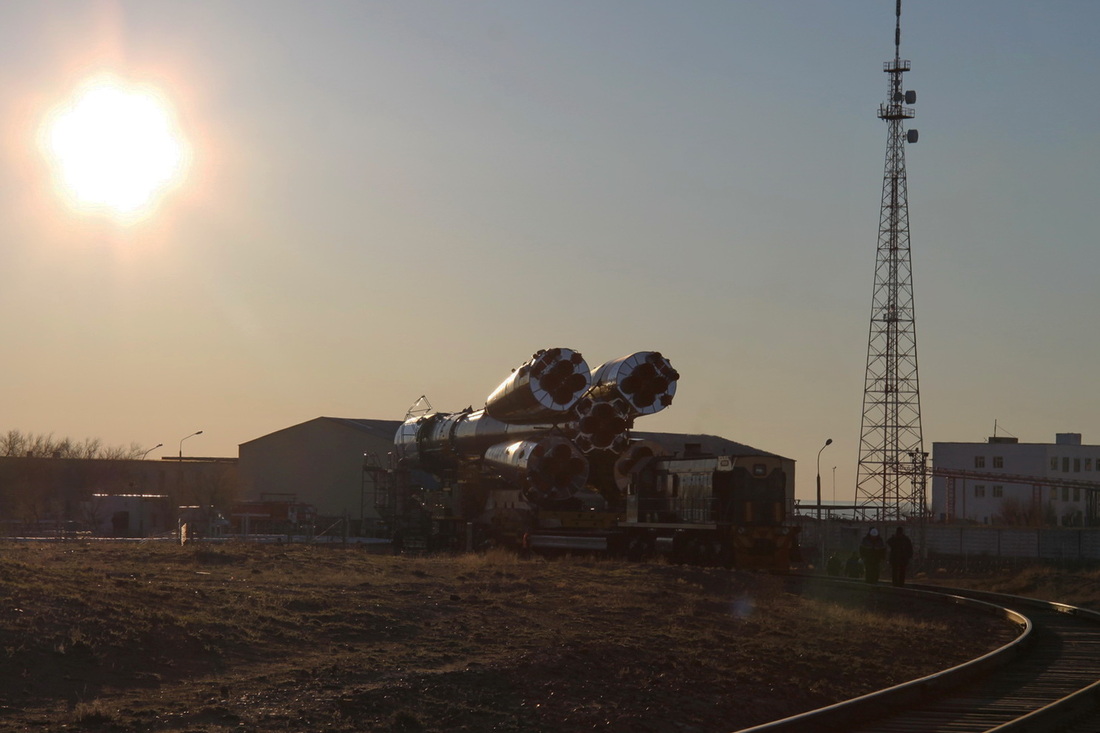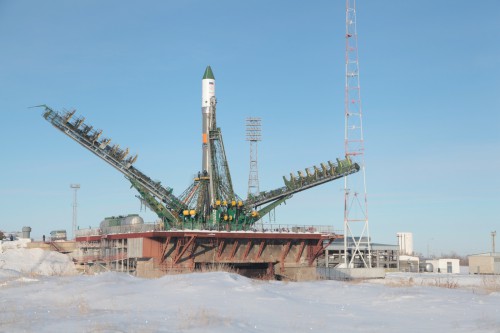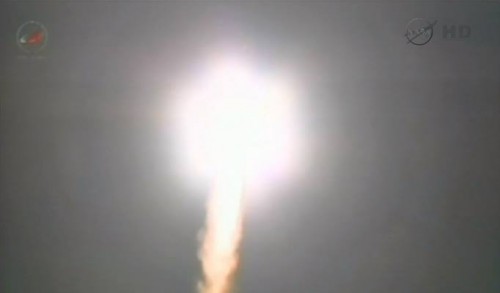
Egypt will launch its second remote-sensing satellite into orbit tomorrow (Wednesday, 16 April) atop Russia’s Soyuz-U booster from Baikonur Cosmodrome in Kazakhstan. The EgyptSat-2 mission is currently scheduled to get underway from Site 31/6 at 10:20 p.m. local time (12:20 p.m. EDT) and, following , a nine-minute ascent, will be delivered into an operational orbit of 435 x 435 miles (700 x 700 km), inclined 51.6 degrees to the equator. Configured with a similar payload shroud to that used by Progress cargo missions to the International Space Station (ISS), this is expected to be the last flight of a non-Progress Soyuz-U, before the vehicle is retired in 2015 and replaced by the new Soyuz 2-1A.
EgyptSat-2—also known as “MisrSat-2″—arrived at Baikonur aboard an An-124 transport aircraft in late February to begin final processing for a mission which has already been extensively delayed, due to the failure of its predecessor. EgyptSat-1 was launched into orbit in April 2007, atop a Dnepr rocket from Baikonur. It was equipped with an infrared sensing device and high-resolution multispectral imager, together with a store-and-forward communications payload. It was deposited successfully into a Sun-synchronous orbit, at an altitude of about 410 miles (660 km), inclined 98.1 degrees to the equator. Built jointly by Egypt’s National Authority for Remote Sensing and Space Sciences (NARSS) and Ukraine’s Yuzhnoye Design Bureau, it was the first time that the Arab nation had opted for “technology transfer” during the satellite manufacturing process, rather than simply purchasing the product, as it had done with the NileSat series of communications satellites.

Upon arrival in orbit, the 364-pound (165-kg) EgyptSat-1 was intended to operate for five years and successfully acquired around 5,000 images at ground resolutions of about 25.6 feet (7.8 meters). However, in July 2010, a failure of its S-band communications system forced a premature end to the mission. As a direct result of this failure, in 2011 it was decided to place EgyptSat-2 on hold as the investigative process got underway. At length, the second mission was tentatively scheduled for launch in 2013, but this target was postponed several times. By the time the 2,300-pound (1,050-kg) satellite finally arrived at Baikonur in February 2014, processing of the Soyuz-U were already well advanced. It was noted by NARSS Director Ayman Ad-Dosouqi that 60 percent of EgyptSat-2’s hardware was made by Egypt.
Over the following weeks, EgyptSat-2 underwent extensive testing and was integrated with its Progress-type payload shroud. On Monday, 14 April, atop the Soyuz-U, it was rolled horizontally from the assembly building to Baikonur’s Site 31/6 launch complex, where the vehicle was raised to a vertical orientation. Assuming that other pre-launch milestones are completed satisfactorily, the loading of propellants into the Soyuz-U will get underway about four hours ahead of Wednesday’s launch, when liquid oxygen and a refined form of rocket-grade kerosene (known as “RP-1”) are pumped into the four tapering strap-on boosters, the core stage, and the upper stage. About 60 minutes later, the cryogenics will enter “replenishment” mode, being continually topped up to flight levels until shortly before the scheduled launch time.
According to Spaceflight101, the Soyuz-U’s guidance will be unlocked at T-1 hour, after which the vehicle’s flight software will be unloaded. About 15 minutes later, the service structure will be retracted and the last engineers and technicians will clear the launch pad. At T-6 minutes, the booster will enter its automated countdown sequence, during which time the ordnance to support the launch will be enabled, the first-stage engines will be purged with nitrogen, and cryogenic will be topped-off for the final time. At T-10 seconds, the turbopumps on the central core and the four tapering boosters will awaken and the engines will steadily build up thrust to full power, producing a retraction of the fueling tower and a liftoff into the darkened Baikonur sky at 10:20 p.m. local time (12:20 p.m. EDT).

Rising rapidly, the vehicle will pass 1,100 mph (1,770 km/h) within a minute of launch, and at T+118 seconds, at an altitude of 28 miles (45 km), the four strap-on boosters will exhaust their propellant and be jettisoned. This will leave the central core and its single RD-118 engine to continue the push into orbit. By two minutes into the flight, the Soyuz-U will be traveling at more than 3,350 mph (5,390 km/h). The payload shroud will be discarded shortly thereafter, and, four minutes and 45 seconds after leaving Baikonur, the core stage will separate at an altitude of 105 miles (170 km). The single RD-0110 engine of the final stage will then roar to life to boost EgyptSat-2 into orbit. Due to the fact that the satellite is far lighter than Russia’s Progress cargo vehicles, it was noted by Spaceflight101 that this launch will feature a “direct ascent” into the 435-mile (700-km) planned altitude, after which the vehicle will execute a “pitch-down” maneuver for circularization.
EgyptSat-2 is a hexagonal satellite, equipped with three deployable, fixed solar arrays, together with nickel-hydrogen batteries, and is expected to remain operational for approximately 11 years. Its optical imaging payload will cover the visible and infrared spectral bands, providing a ground resolution of 13.1 feet (four meters) for multispectral imagery and 3.3 feet (one meter) for panchromatic imagery. Key objectives include total coverage of Egypt’s land and maritime territory and their environs for the purposes of mapping, environmental monitoring, and disaster management. Data will be transmitted through an X-band communications terminal at a rate of 300-600 Mbits/sec to ground stations located near Cairo in the north of Egypt and Aswan in the south. Another satellite, DesertSat, with a spatial resolution of 8 feet (2.5 meters) and a specific focus upon desert resources, is scheduled for launch in 2017.
Want to keep up-to-date with all things space? Be sure to “Like” AmericaSpace on Facebook and follow us on Twitter: @AmericaSpace



